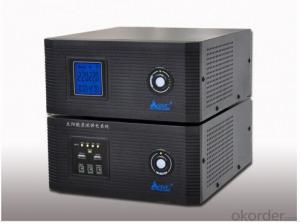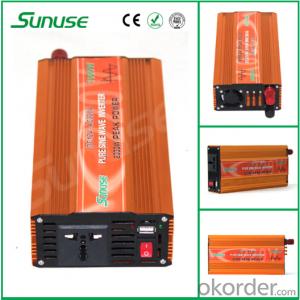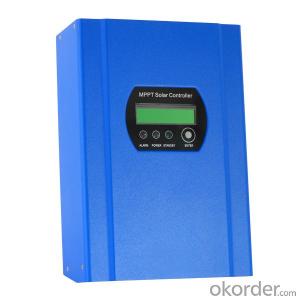Grid Tied Solar Inverter DC to AC Pure Sine Wave Inverter LED/LCD Auto Converter
- Loading Port:
- Guangzhou
- Payment Terms:
- TT OR LC
- Min Order Qty:
- 30 unit
- Supply Capability:
- 300000 unit/month
OKorder Service Pledge
OKorder Financial Service
You Might Also Like

| Model | XL-600 | XL-800 | XL-1000 | XL-1200(12V/24V) | ||
| Capacity | 600VA/500W | 800VA/640W | 1000VA/800W | 1200VA/1000W | ||
| Power factor | 0.8 | |||||
| INPUT | ||||||
| Input voltage range(Inverter mode) | 80~290VAC | |||||
| Input voltage range(UPS mode) | 175~270VAC | |||||
| OUTPUT | ||||||
| Input voltage range(Inverter mode) | 80~290VAC/Same as AC(AC mode), 220VAC±5%(Batt. Mode) | |||||
| Input voltage range(UPS mode) | 175~270VAC/Same as AC(AC mode), 220VAC±5%(Batt. Mode) | |||||
| Output frequency | 50±0.5Hz(Batt. mode) | |||||
| Output wave form | Sine wave (Batt. mode) | |||||
| Transfer time | Max.10ms | |||||
| BATTERY | ||||||
| Battery voltage | DC12V | DC12V/24V | ||||
| Charging current | 12A | 12A | 15A | 15A | ||
| PHYSITAL | ||||||
| (kg) / Net weight (kg) | 7.6 | 8.5 | 10.8 | 12.5 | ||
| (mm) / Unit dimention (mm) | 290*255*120 | |||||
| ENVIRONMENT | ||||||
| Environment of performance | Temperature 0℃~40℃, Humidity 20%~90% | |||||
| Noise level | Less than 40dB | |||||
| MANAGEMENT | ||||||
| RJ45/11 & USB | No | |||||

1. Wide range of input voltage
The UPS can offer normal and stable service voltage under its input voltage range. When the input voltage is out of its range the machine will switch to battery mode automatically to keep the output power in order to protect the equipment, such as computers, ensure they will not be damaged by the over high or over low voltage, users can continue the operation of equipment for a while or save the data on computers while the power network is abnormal.
2. Wide range of AVR(Automatic voltage regulation)
In the product’s input voltage range and under 3 steps of intelligent AVR function, it can provide a stable output voltage.
3. Automatic self detection when UPS on(LED).
Before the UPS on, red, yellow, blue LED will light up two times by cycle turns, after self detection UPS switch to AC mode/battery mode or working mode.
4. Silence function
In the "battery mode", shortly press the switch to turn off the buzzer. But the battery is about to run out or the load is too heavy, the buzzer sound cannot be muted.
5. Overload protection
In the battery mode, output voltage turn down correspondingly when it is overload, after the capacity of load is lower than the rated power then output voltage will back to rated value, it ensures the UPS will not shut down by abrupt overload which caused by surging current during the computer is working and other equipment is added.
6. Short circuit protection
When the mis-operation caused the load short circuit or computer failure (such as power tube breakdown of switch) cause short circuit, the UPS will shutdown automatically for protection.
7. The low current switch
This UPS adopts low current switch to extend the service life which is longer than conventional battery and high current switch in AC current path.
8. Automatic charging
There are two charging mode, charging time is faster than ordinary charging mode, higher efficiency, and greatly prolonging the service life of the battery.
9. With a bypass output
Independent bypass output socket for external printers or scanners of computer peripherals, with surge protection of the load.



FAQ
1. How fast will my system respond to a power outage?
Our solar inverters typically transfer to battery power in less than 16 milliseconds (less than 1/50th of a second).
2. What kind of batteries do the systems include?
Our solar backup electric systems use special high-quality electric storage batteries.
3. How do I install my system?
A solar backup inverter is connected to a home electric system , we will supply detailed installation manual and videos for our customers .
- Q: How do you calculate the efficiency of a solar inverter?
- The efficiency of a solar inverter can be calculated by dividing the output power of the inverter by the input power it receives from the solar panels. This ratio is then multiplied by 100 to express the efficiency as a percentage.
- Q: How does the input current rating affect the performance of a solar inverter?
- The input current rating of a solar inverter directly affects its performance as it determines the maximum amount of current that can be supplied to the inverter. If the input current rating is too low, the inverter may not be able to handle the power generated by the solar panels efficiently, resulting in reduced performance. Conversely, if the input current rating is high, the inverter can handle a larger amount of power and perform optimally. Therefore, selecting an inverter with an appropriate input current rating is crucial for ensuring smooth and efficient operation of a solar power system.
- Q: Can a solar inverter be used with different solar panel types?
- Yes, a solar inverter can generally be used with different solar panel types as long as the electrical specifications of the panels are compatible with the inverter. However, it is important to ensure that the voltage, current, and power ratings of the panels are within the acceptable range for the specific inverter model to ensure optimal performance and safety.
- Q: Can a solar inverter be used with different types of solar cell technologies?
- Yes, a solar inverter can be used with different types of solar cell technologies. Solar inverters are designed to convert the DC electricity generated by solar panels, regardless of the type of solar cell technology, into AC electricity that can be used to power homes and businesses. Therefore, whether it is monocrystalline, polycrystalline, thin-film, or any other solar cell technology, a solar inverter can efficiently convert the generated electricity into usable form.
- Q: How does a solar inverter prevent reverse current flow?
- A solar inverter prevents reverse current flow by using built-in diodes that act as one-way valves, allowing electricity to flow only in the desired direction from the solar panels to the grid or battery system.
- Q: How does a solar inverter synchronize with the grid frequency?
- A solar inverter synchronizes with the grid frequency by continuously monitoring the frequency of the electrical power supplied by the grid. It adjusts its own output frequency to match the grid frequency using a built-in control mechanism. This synchronization ensures that the solar inverter's power is in phase with the grid power, allowing it to smoothly inject electricity into the grid without causing disruptions or power quality issues.
- Q: How does a solar inverter handle grid faults and disturbances?
- A solar inverter is designed to handle grid faults and disturbances by continuously monitoring the grid conditions. In the event of a fault or disturbance, such as a voltage or frequency fluctuation, the solar inverter will quickly disconnect from the grid to ensure the safety of the system. Once the fault is resolved and the grid conditions stabilize, the solar inverter will reconnect to the grid and resume normal operation, ensuring a reliable and stable power supply.
- Q: How does a solar inverter handle grid islanding conditions?
- A solar inverter handles grid islanding conditions by continuously monitoring the grid voltage and frequency. If it detects a deviation from the predefined range, it immediately disconnects from the grid to prevent energy feedback and potential damage. This ensures the safety of workers repairing the grid and protects the solar system from potential overvoltage or frequency-related issues.
- Q: Can a solar inverter be used in a floating solar system?
- Yes, a solar inverter can be used in a floating solar system. The inverter is an essential component of a solar power system that converts the direct current (DC) generated by the solar panels into alternating current (AC) electricity that can be used to power various devices or be fed into the grid. Whether the solar panels are installed on the ground, rooftops, or floating platforms, the inverter's role remains the same. Therefore, it can certainly be used in a floating solar system to ensure efficient and reliable power conversion.
- Q: What is the role of a solar inverter in a solar-powered electric fence?
- The role of a solar inverter in a solar-powered electric fence is to convert the direct current (DC) generated by the solar panels into alternating current (AC) that is used to power the electric fence system. The inverter ensures that the energy captured by the solar panels is transformed into a usable form for the electric fence, allowing it to function efficiently.
Send your message to us
Grid Tied Solar Inverter DC to AC Pure Sine Wave Inverter LED/LCD Auto Converter
- Loading Port:
- Guangzhou
- Payment Terms:
- TT OR LC
- Min Order Qty:
- 30 unit
- Supply Capability:
- 300000 unit/month
OKorder Service Pledge
OKorder Financial Service
Similar products
Hot products
Hot Searches
Related keywords



























